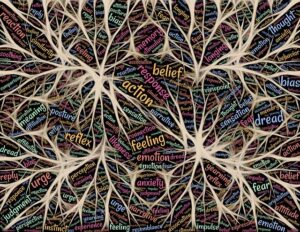By Géric Lebedoff
Editor’s Note: The names have been anonymized and permission given by the clients to share their experience.
Elisa came to me a few days before a 10-day holiday with her 21-year-old son, Thomas. They had planned to explore Portugal’s local beaches, have time to relax and be together. But she felt uneasy, stressed about the trip.
Her history was rather classic. She was divorced; had had a boy, an only child. As it often happens when parents separate, they share their feelings (verbally and non-verbally) with their children imposing their point of view on their children. And as happens with children in this situation, they learn quickly, if they don’t already know how, to play with their parents’ feelings and how to take advantage of the situation and turn things to their own benefit. Thomas was quite practiced at the art of manipulation.
Furthering Elisa’s difficulties, her former husband had remarried and fathered two girls. Thomas demonstrated a clear loss of self-worth; he obviously was looking for an identity that he was not yet able to comprehend. His father‘s decision to send him to business school disregarding his desire to be a photographer (his father was in the movie business as a technician in filming) did not help solve the boy’s quest to find his answer to “Who am I?”
Elisa held unabated unconditional love for Thomas but was always on his back trying to teach him what to do and not to do. This was not an optimal route to follow either.
The session went well. Compassion, empathy, safety resulted from our time together. I felt it would be useful to share some insights into teenagers (defined as children between the ages of 10 and 25) and how their brains function and develop.
Why?
Because I feel it is good practice to advise and explain what’s happening in younger brains, so parents know more about what lies beneath their children’s behavior. And, as you may surely appreciate, it is a whole lot!
 The Brain: A Miracle of Myelination
The Brain: A Miracle of Myelination
My own education in this field is based on many readings, but a few books are basic on the subject: Frances E. Jensen‘s, The Teenager Brain (1), Gordon Neufeld and Gabor Mate‘s, Hold On To Your Kids (2) and on many basic principles, Steven Porges‘, Polyvagal Theory (3).
We typically accept that 3-year-olds have not yet developed the capacities to control themselves, but I invite you to also consider that, similarly, teens have not yet determined how to control themselves. Their hormones are in full blast, and their brains have not yet figured out how to handle these hormones, i.e., how to regulate their bodies in response to a new batch of chemicals. Concentrations of testosterone, estrogen, and progesterone provoke physical changes (voice tone, facial hair, menstruation, breasts) and can provoke emotional upsurges in seconds. Testosterone is particularly active in the limbic system—it interacts with the amygdala, which is involved in processing emotion and fears and in coordinating physiological responses based on outside information (the “fight or flight” response).This hormonal activity is what, in part, explains why adolescents are so inconsistent and capricious, emotionally speaking. It’s not that teens have higher hormonal levels than adults, they merely react in a different way. That is mere biology (4).
Research has shown (5) that teenage brains are only about 80% mature. The remaining 20% is of the utmost importance and gives clues as to why teens react so oddly (i.e., mood swings, an inability to stay focused, compulsivity, impulsiveness, an inability to follow through and to connect with parents, addiction to drugs and alcohol.)
A mature brain connects from back to front because myelination of white matters evolves. The executive brain (frontal cortex) is the last to connect and is delayed until age 20 or older. The point here is to realize that complete myelination is key to ensure brain integration and connectivity and that three decades of life are needed for full myelination to occur. Knowing that myelin increases the rate at which information is passed along the axons means that without proper myelination when a danger signal is sent by the amygdala, there are problems for the teenaged brain to link up with executive brain function. The teen might thus put himself in danger not knowing what to do next (6). This means that the amygdala sends signals of danger, but the executive brain does not interact in the decision-making process, hence poor decision making.
After our first session, Elisa had a good understanding as to why and how her son might look like an adult in many ways but was unable to do certain things because of intellectually, emotionally and behaviorally biological restraints in his brain. I helped her understand the necessity of conveying clear messages to her son, including the fact that the brain may sometimes be an explanation but is never an excuse. Hence the importance for Elisa to set non-ambiguous boundaries with Thomas.
The next issue then becomes what to do during periods of time when parents see their beloved children go without an anchor for whatever they are trying to do.
Gordon Neufeld and Gabor Mate are clear on the subject: parenting authority and love is key to foster attachment, and attachment is key to helping children grow in the most balanced way. ”The disorder affecting the generations of young children and adolescents towards adulthood is rooted in the loss of orientation of children towards the nurturing adults in their lives” ( 7 ).
I agree. Children are looking for guidance and too often they are looking for guidance from their peers who are not mature themselves. Thus, they cannot possibly guide them, nor orient them in a way that allows them to get properly acquainted with this erratic, stressing, albeit so beautiful a world in which they live.
The problem is that although there is a powerful, embedded-need towards attachment in each child, there is no embedded, inherited-circuitry that pushes a child to seek attachment with the mother or father, or a teacher or mentor. There is simply an inherited circuitry to turn towards a source of authority, connection, and warmth, and this could be whoever is near. Peers have taken the place in an orienting-void created by our society.
Families have exploded; they are torn apart. Mom and dad are busy working at the office and grandma and grandpa often live away somewhere in the countryside. Peers, however, are there all the time and become the main influence on the development of the members of the pack. The good news is that there is much that can be done by Elisa and any parent to remedy the situation.
 Steps Toward Family Attachment
Steps Toward Family Attachment
First Elisa needs to trust in her son’s desire to be good, honest, trustworthy. Even if it is normal for Elisa to react by saying, “How can I trust a kid who is permanently lying to me?”, it is nonetheless crucial to trust his desire to be good and to treasure and nurture that desire in him. Indeed, it is not the child’s ability to perform the parent expectations but the desire to be good to the parents that needs to justify the parent’s trust.
I know this is tough, is it not? But it so important!
Now, of course we don’t want Elisa’s son to be blocked in immaturity. The problem here is that physical growth is not automatically accompanied by psychological and emotional maturation.
Peer orientation is often the culprit. The earlier the commencement of peer orientation in a child’s life, the greater the likelihood of being doomed to perpetual childishness. Of course, maturation cannot be commanded. One cannot teach children how to be individuals or train them to be their own identities. This is the work of maturation and maturation alone. We can help the process, provide the right environment, and remove most obstacles, but we cannot order a child to grow up. No more than we can ask a plant in our garden to grow up. No short cut is available here.
The challenge for Elisa is thus going to be helping her son to grow up, because for the time being, he merely looks like a grown up.
Nowadays we know that the key ingredient to activate maturation is attachment. A rather straightforward and self-evident fact. Attachment is the first priority in all living things. Give children love so they can be seen, felt, and heard and they will flourish. We must provide children a sense of belonging, keep them close by providing contact and connection even if they are not seeking it. When they ask for a hug, we need to give them a warmer one than the one they are giving us. There is a paradox here “dependence and attachment foster independence and separation” (8).
Carl Rogers (9) refers to “unconditional positive regard “, a regard that is not possessive, that demands no personal gratification. Unconditional positive regard and thus love are the indispensable ingredients that promote healthy emotional growth. The first task is to create space in the child’s heart for the certainty that he is precisely the person that the parent wants and love. He does not have to do anything or be different to earn that certainty. In fact, he cannot do anything because that love cannot be won nor lost.
Here the challenge for Elisa will thus be to convey to Thomas the unacceptability of certain behaviors without making her son feel unacceptable.
Children need to experience enough security and enough unconditional love for the required energy to be provided, to grow and to mature. Elisa needs to give her son what peers cannot give to one another: the freedom to be oneself in the context of loving acceptance. An acceptance that immature peers are unable to give.
A top priority for Elisa will thus be to collect her son, making him want to belong to her and with her. In the chaotic family environment that we live nowadays, she will nonetheless need to make it possible to gather with her son and do this repeatedly until he is old enough to function as an independent being. The good news is that instinctively most mothers seem to know how to do this.
The starting point and primary goal with her son ought to be the relationship itself, not the conduct or behavior.
It seems that the older children become, the more the maternal choice to confront their children when something goes wrong. At the active toddler stage, 90% of maternal behavior consist of affection, play, and care giving, with only 5% designed to prohibit the toddler from ongoing activity.
 Remember to never forego the courtship behavior. It is a mistake in adult attachment and a disaster with children. Elisa will need to keep confronting her son when things need to be address but she needs to do so in ways that are warranting and inviting, that keep enticing him to stay in relationship with her.
Remember to never forego the courtship behavior. It is a mistake in adult attachment and a disaster with children. Elisa will need to keep confronting her son when things need to be address but she needs to do so in ways that are warranting and inviting, that keep enticing him to stay in relationship with her.
I often invite parents to recall the content of most of their contact with their children. Most often, they address their children in order to have them do something or to teach them something or have them change their behavior. How often is the connection about being together and merely enjoying one another’s company?
In Conclusion
In a world where we often are separated, unless we can connect with our children, not much will go right. Unfortunately, there’s no ‘by the book’ prescription that fits all parents and all children. It is going to be trial and error. I also remind parents to reconnect with their children after a tense experience or argument. If an emotional separation occurs after a fight or argument, the parenting connection is going to be lost unless the parent moves to restore what Gershon Kaufman called the “interpersonal bridge” (10). Rebuilding that bridge is always the parents’ responsibility. Never ever expect children to do it. They simply do not have the maturity to do so.
 The bottom line is that emotional warmth, gladness and nurturing are at the top of the list as effective activators of attachment. Children must know they are wanted, special, significant, seen, recognized, missed, heard, and loved.
The bottom line is that emotional warmth, gladness and nurturing are at the top of the list as effective activators of attachment. Children must know they are wanted, special, significant, seen, recognized, missed, heard, and loved.
I admit that it often takes a Saint to not feel withdrawn and separated by the pretentiousness, huffiness and disloyalty of our teenagers. And when the relationship is getting hot, staying in the game, not becoming alienated is one of the most important things we can do for our children’s sake and ours.
Not infrequently, in an act of despair, parents will send an ultimatum. It rarely works. It might work sometimes, but then, only if there is a strong enough attachment.
As I said to Elisa, “I am not telling you that you will not be triggered into emotionally uncontrolled reactions by your son.”
Temporary ruptures in relationships are unavoidable and per se not harmful. The real harm is inflicted when parents neglect to reconnect with their children, thus releasing the message that the relationship is not important to them.
As I told Elisa: “At one point, you will always need to come back and be able to say, ‘I am still your mom and always will be. I know it is hard to remember that I love you when I am mad, and sometimes I may even forget it myself for a moment or two, but I always come back to my senses. I am glad our connections are strong’” (11).
A Final Note
Elisa later reported to me that they were having a marvelous holiday together. Their re-collection and reconnection had been perfect and amazingly positive.
Géric Lebedoff is a psychotherapist with a private practice in Paris ,France .He is specialized in traumatologie and anxiety disorder .
Photo Credits:
Yannick Menard: Unsplashed
John Hain Pixabay
Gerd Altmann Pixabay
Blake Barlow Unsplashed
Public Domain Pictures Pixabay
Anna Kolosyuk Unsplashed
Footnotes:
(1) Frances E. Jensen. The Teenager Brain. Harper Collins Publishers 2015. (referred to infra as “Jensen”)
(2) Gordon Neufeld and Gabor Mate. Hold on to your Kids. Ballantine Books, Paperback edition, 2014. (Referred to supra as Neufeld/Mate).
(3) Steven Porges. The Polyvagal Theory. W.W. Norton & Company, 2011.
(4) Jensen, p. 22
(5) Teenager Brain: A Work in Progress. NIMH fact sheet, 2001.
(6) Red Cross Study Reveals Problems with Teenagers and Drink. Guardian, September 12, 2010.
(7) Neufeld/Mate, p. 7.
(8) Neufeld/Mate, p. 116.
(9) Carl Rogers. On Becoming a Person: A Therapist View of Psychotherapy. Mariner Books, September 7, 1995.
(10) Gershon Kaufman, quoted in Neufeld/Mate p. 182.
(11) Neufeld/Mate, p. 200.








